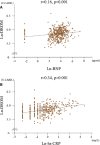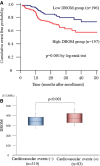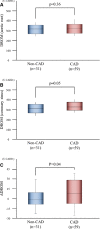Reactive oxygen metabolites are closely associated with the diagnosis and prognosis of coronary artery disease
- PMID: 25630910
- PMCID: PMC4345871
- DOI: 10.1161/JAHA.114.001451
Reactive oxygen metabolites are closely associated with the diagnosis and prognosis of coronary artery disease
Abstract
Background: Reactive oxygen species (ROS) are associated with development of coronary artery disease (CAD). However, there's no useful biomarker of ROS in CAD.
Methods and results: We recruited 395 consecutive CAD patients who were performed coronary angiography (262 male and 133 female, age 70.2±10), and we measured serum derivatives of reactive oxidative metabolites (DROM) were measured. Two hundred twenty-seven non-CAD patients were also enrolled. We performed follow-up study in these 395 CAD patients and case-control study after risk factor and 1:1 pair matching (both, n=163). As subgroup analysis, DROM were also measured at the aortic root and the coronary sinus in 59 CAD patients. DROM were significantly higher in CAD patients (n=163, median [inter-quartile range, IQR]=338 [302 to 386]) than in risk factor-matched non-CAD patients (n=163, 311 [282 to 352.5], effect size=0.33, P<0.001). During a mean follow-up period of 20 months of 395 CAD patients, 83 cardiovascular events were recorded. Kaplan-Meier analysis showed a higher probability of cardiovascular events in the high-DROM group (>346 U.CARR) than in the low-DROM group (≤346 U.CARR) (P=0.001 [log-rank test]). Multivariate Cox hazard analysis identified ln-DROM as an independent predictor for cardiovascular events (hazard ratio: 10.8, 95% confidence interval: 2.76 to 42.4, P=0.001). The transcardiac gradient of DROM was significantly higher in CAD patients than in non-CAD patients (-2.0 [-9.0 to 9.0] versus 8 [-8.0 to 28.3], effect size=0.21, P=0.04), indicating that DROM production in coronary circulation is associated with development of CAD.
Conclusion: DROM are increased in CAD patients and associated with future cardiovascular events. DROM might provide clinical benefits for risk stratification of CAD.
Clinical trial registration url: http://www.umin.ac.jp/ctr/. Unique identifier: UMIN000012990.
Keywords: cardiovascular events; coronary artery disease; coronary circulation; follow‐up study; reactive oxygen species.
© 2015 The Authors. Published on behalf of the American Heart Association, Inc., by Wiley Blackwell.
Figures






Similar articles
-
The Pivotal Role of a Novel Biomarker of Reactive Oxygen Species in Chronic Kidney Disease.Medicine (Baltimore). 2015 Jun;94(25):e1040. doi: 10.1097/MD.0000000000001040. Medicine (Baltimore). 2015. PMID: 26107676 Free PMC article.
-
Prognostic significance of circulating leukocyte subtype counts in patients with coronary artery disease.Atherosclerosis. 2016 Dec;255:210-216. doi: 10.1016/j.atherosclerosis.2016.08.033. Epub 2016 Aug 25. Atherosclerosis. 2016. PMID: 27612676
-
Impact of Reactive Oxidative Metabolites Among New Categories of Nonischemic Heart Failure.J Am Heart Assoc. 2021 Apr 6;10(7):e016765. doi: 10.1161/JAHA.120.016765. Epub 2021 Mar 18. J Am Heart Assoc. 2021. PMID: 33733816 Free PMC article.
-
Premature coronary artery disease: clinical risk factors and prognosis.Curr Atheroscler Rep. 2004 Mar;6(2):121-5. doi: 10.1007/s11883-004-0100-z. Curr Atheroscler Rep. 2004. PMID: 15023296 Review.
-
27th Bethesda Conference: matching the intensity of risk factor management with the hazard for coronary disease events. Task Force 5. Stratification of patients into high, medium and low risk subgroups for purposes of risk factor management.J Am Coll Cardiol. 1996 Apr;27(5):1007-19. doi: 10.1016/0735-1097(96)87733-3. J Am Coll Cardiol. 1996. PMID: 8609316 Review. No abstract available.
Cited by
-
Emerging Biomarkers of Oxidative Stress in Acute and Stable Coronary Artery Disease: Levels and Determinants.Antioxidants (Basel). 2019 May 1;8(5):115. doi: 10.3390/antiox8050115. Antioxidants (Basel). 2019. PMID: 31052417 Free PMC article.
-
HFE p.C282Y gene variant is associated with varicose veins in Russian population.Clin Exp Med. 2016 Aug;16(3):463-70. doi: 10.1007/s10238-015-0377-y. Epub 2015 Sep 28. Clin Exp Med. 2016. PMID: 26416403
-
Development of a Microminipig Model of Atherosclerosis for the Evaluation of a HMGCR Inhibitor.In Vivo. 2024 Jan-Feb;38(1):98-106. doi: 10.21873/invivo.13415. In Vivo. 2024. PMID: 38148058 Free PMC article.
-
A comparative study of time-specific oxidative stress after acute myocardial infarction in patients with and without diabetes mellitus.BMC Cardiovasc Disord. 2016 May 23;16:102. doi: 10.1186/s12872-016-0259-6. BMC Cardiovasc Disord. 2016. PMID: 27216220 Free PMC article.
-
Potential objective biomarkers for fatigue among working women.J Occup Health. 2017 May 25;59(3):286-291. doi: 10.1539/joh.16-0206-BR. Epub 2017 Feb 4. J Occup Health. 2017. PMID: 28163282 Free PMC article.
References
-
- Bonow RO, Smaha LA, Smith SC, Jr, Mensah GA, Lenfant C. World Heart Day 2002: the international burden of cardiovascular disease: responding to the emerging global epidemic. Circulation. 2002; 106:1602-1605. - PubMed
-
- Griendling KK, FitzGerald GA. Oxidative stress and cardiovascular injury: part I: basic mechanisms and in vivo monitoring of ROS. Circulation. 2003; 108:1912-1916. - PubMed
-
- Griendling KK, FitzGerald GA. Oxidative stress and cardiovascular injury: part II: animal and human studies. Circulation. 2003; 108:2034-2040. - PubMed
-
- Ashfaq S, Abramson JL, Jones DP, Rhodes SD, Weintraub WS, Hooper WC, Vaccarino V, Harrison DG, Quyyumi AA. The relationship between plasma levels of oxidized and reduced thiols and early atherosclerosis in healthy adults. J Am Coll Cardiol. 2006; 47:1005-1011. - PubMed
Publication types
MeSH terms
Substances
LinkOut - more resources
Full Text Sources
Medical
Research Materials
Miscellaneous

